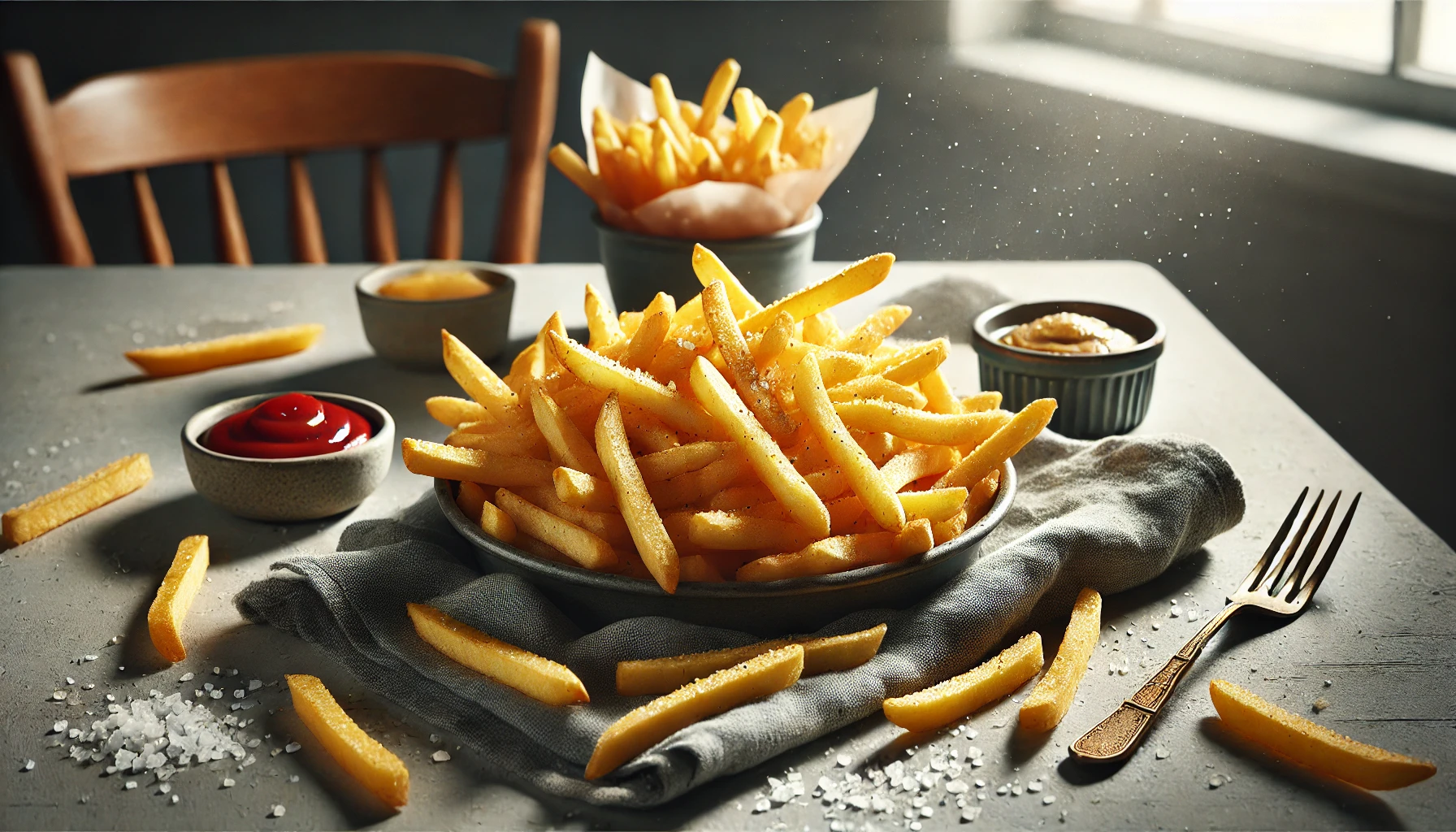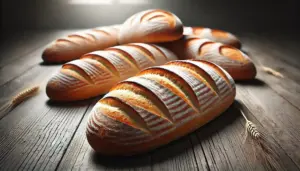Pommes Frites, more commonly known as “French Fries” in English-speaking countries, are a beloved snack and side dish enjoyed worldwide. While often associated with fast food, Pommes Frites have a rich history, evolving from a humble street food in Europe to a global culinary icon. This article explores the origin of Pommes Frites, their nutritional profile, varieties, cooking methods, and tips on achieving the perfect crispy fry at home. We’ll also look at some creative ways to enjoy Pommes Frites with different seasonings, sauces, and toppings.
The Origin of Pommes Frites
Despite the name “French Fries,” there is an ongoing debate about whether these delicious potato sticks originated in France or Belgium. Here’s a brief look at both claims:
- Belgian Claim: According to Belgian folklore, the villagers in the Meuse Valley began frying potatoes in the late 17th century. When the rivers froze during winter, they couldn’t fish, so they fried potatoes in fish shapes as a substitute. Belgium considers itself the true birthplace of Pommes Frites and has a strong culture around fries, often serving them in paper cones with mayonnaise.
- French Claim: The French claim that Pommes Frites were created by street vendors on the Pont Neuf bridge in Paris in the late 18th century. These vendors sold fried potatoes as a snack, and the popularity of the dish spread across the country.
Regardless of the true origin, Pommes Frites became widely popular in both countries and eventually around the world. Today, both Belgium and France take pride in their unique fry-making techniques, often arguing over who makes the best version.
Nutritional Profile of Pommes Frites
While Pommes Frites are often viewed as a guilty pleasure, they do contain essential nutrients when consumed in moderation. Potatoes, the primary ingredient, are rich in vitamins, minerals, and fiber. However, the nutritional content of Pommes Frites can vary greatly depending on the cooking method and type of oil used. Here’s a breakdown of the average nutritional values per 100g of Pommes Frites made with vegetable oil:
- Calories: 312 kcal
- Carbohydrates: 41g
- Protein: 3.4g
- Fat: 15g
- Fiber: 3.8g
- Vitamin C: 8 mg
- Potassium: 579 mg
- Sodium: 210 mg (varies with salt)
Health Considerations:
- High in Carbohydrates: Potatoes are naturally high in carbohydrates, which provide quick energy.
- Good Source of Fiber: Fiber helps with digestion and promotes a feeling of fullness.
- Rich in Potassium: Potassium supports heart health and helps regulate blood pressure.
- Fats and Calories: Since Pommes Frites are deep-fried, they contain a higher fat and calorie content. Air frying or baking can reduce the calorie count while still achieving a satisfying crispiness.
Types of Pommes Frites
Pommes Frites can be prepared in a variety of cuts, each offering a unique texture and taste. Here are some of the most popular types:
- Classic French Fries: Straight-cut and moderately thick, these are the most commonly found Pommes Frites, ideal for dipping and holding sauces.
- Shoestring Fries: Thinner than classic fries, shoestring fries are extra crispy due to their smaller size, making them perfect for seasoning blends.
- Steak Fries: Thicker and chunkier, steak fries are soft on the inside and pair well with hearty meals.
- Waffle Fries: With their unique shape, waffle fries have more surface area for crispiness and are ideal for scooping up dips.
- Curly Fries: Spiral-shaped and often seasoned, curly fries offer a fun twist and are highly popular in fast food.
- Belgian Frites: Slightly thicker than classic French fries and traditionally fried twice for extra crispiness, Belgian frites are usually served in paper cones with a variety of dipping sauces.
Achieving the Perfect Pommes Frites at Home
Creating restaurant-quality Pommes Frites at home may seem challenging, but with the right steps and a bit of patience, you can achieve the perfect fry. Here’s a step-by-step guide to making crispy, golden Pommes Frites:
Ingredients:
- 4 large Russet potatoes (known for their high starch content, ideal for fries)
- Cold water (for soaking)
- Vegetable oil or peanut oil (for frying)
- Salt to taste
Preparation Steps:
- Peel and Cut Potatoes: Peel the potatoes and cut them into even, 1/4-inch thick sticks. Uniform sizes ensure even cooking.
- Soak the Potatoes: Soak the cut potatoes in cold water for at least 30 minutes (or up to 2 hours). This removes excess starch, preventing the fries from sticking together and helping them crisp up.
- Dry the Potatoes: After soaking, drain the water and thoroughly pat the potatoes dry with a paper towel. Removing excess moisture is essential for achieving a crispy texture.
- Pre-fry (Blanch) the Potatoes: Heat oil to about 300°F (150°C) in a deep fryer or a heavy pot. Fry the potatoes in small batches for 3-4 minutes, until they are soft but not browned. This initial fry cooks the potatoes without creating a crust.
- Cool the Potatoes: Remove the fries from the oil and let them cool on a baking sheet lined with paper towels. Allowing them to rest for 10–15 minutes is crucial for a crispy final fry.
- Final Fry: Increase the oil temperature to 375°F (190°C). Fry the potatoes a second time for 2-3 minutes, or until they turn golden brown and crispy. Work in batches to prevent overcrowding.
- Season and Serve: Drain the fries on paper towels to remove excess oil, then season with salt while they’re hot. Serve with your favorite dipping sauces.
Creative Seasonings and Dips for Pommes Frites
Pommes Frites are versatile and can be enjoyed with a wide range of seasonings and dips. Here are some popular options to elevate your fries:
Seasoning Ideas:
- Herb-Infused Salt: Mix sea salt with finely chopped rosemary, thyme, and parsley for an aromatic touch.
- Garlic Parmesan: Toss hot fries with minced garlic and grated Parmesan cheese for a savory twist.
- Truffle Salt: A sprinkle of truffle salt adds an earthy, gourmet flavor to your fries.
- Cajun Spice: For a Southern flavor, mix cayenne pepper, paprika, garlic powder, and onion powder for a spicy kick.
- Paprika and Smoked Salt: This combination adds a subtle smokiness to the fries, enhancing their flavor.
Dipping Sauces:
- Classic Ketchup: Always a favorite, especially with kids.
- Garlic Aioli: A creamy garlic mayonnaise adds a luxurious richness to fries.
- Cheese Sauce: Melted cheese sauce is perfect for dipping thicker fries like steak fries.
- Spicy Mayo: Mix mayonnaise with sriracha or chili paste for a spicy-sweet dip.
- Belgian-Style Mayonnaise: Creamy, tangy, and slightly sweet, this mayonnaise variation is often paired with Belgian frites.
Fun Facts About Pommes Frites
- Pommes Frites Day: Belgium celebrates National Fries Day on the first Friday of every August, where people indulge in fries from local vendors.
- The World’s Largest French Fry: The record for the largest French fry was set in 2018, measuring 8.83 inches long.
- Pommes Frites in Space: In 1995, NASA and the University of Wisconsin created the first potatoes grown in space, hinting at future interstellar Pommes Frites!
Healthier Alternatives to Traditional Pommes Frites
While traditional Pommes Frites are deep-fried, there are healthier cooking methods to enjoy this classic snack with fewer calories and less fat.
- Baked Fries: Toss the potatoes in a small amount of oil and bake at 425°F (220°C) until crispy. Baked fries contain significantly less oil but still achieve a crispy texture.
- Air-Fried Fries: Air fryers circulate hot air to cook the potatoes, using minimal oil. Air-fried fries are an excellent alternative for a lower-calorie option with a similar crunch.
- Sweet Potato Fries: For added nutrition, use sweet potatoes instead of regular potatoes. They are naturally higher in vitamins A and C and can be prepared using the same methods.
Conclusion
Pommes Frites have journeyed from humble beginnings in Europe to become one of the world’s most beloved foods. Whether enjoyed with a simple sprinkle of salt or dressed up with truffle oil and gourmet sauces, Pommes Frites are a universally loved dish that transcends cultures and cuisines. By understanding their origin, experimenting with different cuts, and trying out new seasonings, you can appreciate Pommes Frites in a whole new way.
Whether you prefer classic French Fries or are eager to try Belgian-style frites, making Pommes Frites at home can be a rewarding culinary experience. So, gather your potatoes, heat up the oil, and treat yourself to a delicious batch of homemade fries because Pommes Frites are always a good idea.
!


